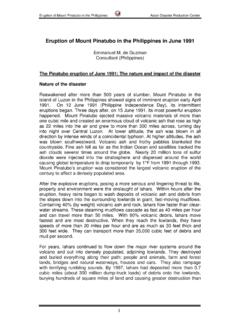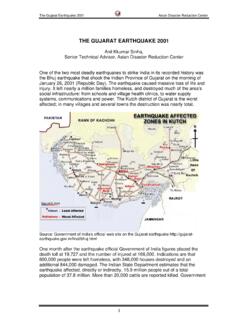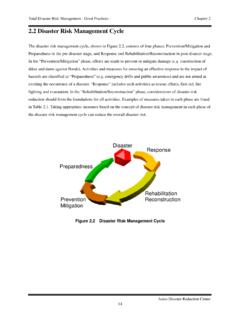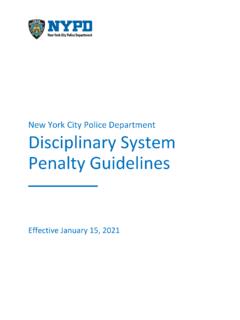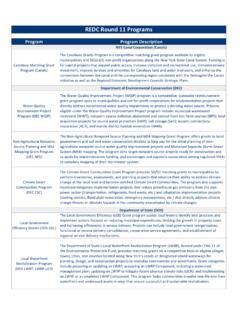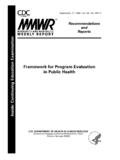Transcription of Eruption of Mount Pinatubo in the Philippines in June 1991
1 Eruption of Mount Pinatubo in the Philippines Asian Disaster Reduction Center Eruption of Mount Pinatubo in the Philippines in June 1991 Emmanuel M. de Guzman Consultant ( Philippines ) The Pinatubo Eruption of June 1991: The nature and impact of the disaster Nature of the disaster Reawakened after more than 500 years of slumber, Mount Pinatubo in the island of Luzon in the Philippines showed signs of imminent Eruption early April 1991. On 12 June 1991 (Philippine Independence Day), its intermittent eruptions began. Three days after, on 15 June 1991, its most powerful Eruption happened. Mount Pinatubo ejected massive volcanic materials of more than one cubic mile and created an enormous cloud of volcanic ash that rose as high as 22 miles into the air and grew to more than 300 miles across, turning day into night over Central Luzon.
2 At lower altitude, the ash was blown in all direction by intense winds of a coincidental typhoon. At higher altitudes, the ash was blown southwestward. Volcanic ash and frothy pebbles blanketed the countryside. Fine ash fell as far as the Indian Ocean and satellites tracked the ash clouds several times around the globe. Nearly 20 million tons of sulfur dioxide were injected into the stratosphere and dispersed around the world causing global temperature to drop temporarily by 1*F from 1991 through 1993. Mount Pinatubo s Eruption was considered the largest volcanic Eruption of the century to affect a densely populated area. After the explosive eruptions, posing a more serious and lingering threat to life, property and environment were the onslaught of lahars.
3 Within hours after the Eruption , heavy rains began to wash deposits of volcanic ash and debris from the slopes down into the surrounding lowlands in giant, fast-moving mudflows. Containing 40% (by weight) volcanic ash and rock, lahars flow faster than clear-water streams. These steaming mudflows cascade as fast as 40 miles per hour and can travel more than 50 miles. With 90% volcanic debris, lahars move fastest and are most destructive. When they reach the lowlands, they have speeds of more than 20 miles per hour and are as much as 30 feet thick and 300 feet wide. They can transport more than 35,000 cubic feet of debris and mud per second. For years, lahars continued to flow down the major river systems around the volcano and out into densely populated, adjoining lowlands.
4 They destroyed and buried everything along their path: people and animals, farm and forest lands, bridges and natural waterways, houses and cars. They also rampage with terrifying rumbling sounds. By 1997, lahars had deposited more than cubic miles (about 300 million dump-truck loads) of debris onto the lowlands, burying hundreds of square miles of land and causing greater destruction than 1 Eruption of Mount Pinatubo in the Philippines Asian Disaster Reduction Center the Eruption itself. With the volume of volcanic debris deposited on the slopes of Mt.
5 Pinatubo , the threat of lahars is expected to continue until year 2010. The disaster brought about by the Eruption of Mount Pinatubo had assumed a unique nature in view of the following: the widespread devastation that impacts on society and economy, the continuing threat of lahars and flooding, the destruction of endemic species of flora and fauna, the alteration of landscapes and land uses, and its impact on the global environment. Extent of damage and socio-economic impact The Mount Pinatubo eruptions and their aftereffects, particularly lahars during rainy seasons, not only have taken the lives of many but also have wrought havoc to the infrastructure and to economic activities of Central Luzon. Damage to crops, infrastructure, and personal property totaled at least billion ($US 374 million) in 1991, and an additional billion ($US 69 million) in 1992.
6 In addition, an estimated P454 million ($US 17 million) of business was foregone in 1991, and an additional P37 million ($US million) in 1992. Lahars continue to threaten lives and property in many towns in the provinces of Tarlac, Pampanga, and Zambales. The actual destruction, coupled with the continuing threat of lahars and ash fall, had disrupted the otherwise flourishing economy of Central Luzon, slowing the region's growth momentum and altering key development activities and priorities. Major resources had been diverted to relief, recovery, and prevention of further damage. The cost of caring for evacuees, including construction of evacuation camps and relocation centers, was at least billion ($US 93 million) in 1991-1992, and an additional billion ($US 154 million) was spent during the same period on dikes and dams to control lahars.
7 The longevity and impact of the calamity is so great that the public and private response must go beyond traditional relief and recovery. Return to pre- Eruption conditions is impossible. Instead, responses must create an attractive climate for new investments, provide new livelihood and employment alternatives, promote growth in areas that are safe from future lahars and flooding, and provide an infrastructure that is tough enough to survive future disasters. Areas and populations affected During the Eruption of 15 June 1991, heavy ash falls had caused widespread damage in the provinces adjacent to Mount Pinatubo , as they covered large tracts of land and caused the roofs of houses, buildings and public facilities to collapse. These provinces were Zambales, Pampanga and Tarlac.
8 2 Eruption of Mount Pinatubo in the Philippines Asian Disaster Reduction Center The regional office of the Department of Social Welfare and Development (DSWD) had reported a total of 657 persons dead, 184 injured and 23 missing as of 29 September 1991. The casualties were mostly victims of collapsing structures, drowning due to flooding, and diseases in the evacuation center. The provinces of Zambales and Pampanga accounted for most of the victims. Moreover, from June 1991 to November 1992, the means of livelihood, houses, or both were partially or wholly lost in 364 barangays or villages.
9 Per 1990 census, about 329,000 families ( million people) or one-third of the region's population lived in these villages. Table 1. Total number of barangays affected as of November 17, 1992 (National Disaster Coordinating council , 1992). ["Affected" refers to a situation where means of livelihood, houses, or both are lost or partially or completely destroyed] Province Affected barangaysNo. of families Zambales 9630,115 Pampanga 173239,131 Tarlac 8844,367 Angeles city 514,197 Nueva Ecija 21,331 Total 364329,141 In 1991, 4,979 houses were totally destroyed and 70,257 houses were partially damaged. The number decreased in 1992, when 3,281 houses were wholly destroyed and 3,137 units were partially damaged (Table 2).
10 Table 2. Total number of houses damaged (National Disaster Coordinating council , 1992; Presidential Task Force on Mount Pinatubo , 1992; Department of Social Welfare and Development, unpublished data, 1992). [Partial damage refers to any degree of physical destruction attributed to the disaster. Total destruction is the condition when the house is no longer livable] Extent of damage 1991 1992 Total Totally destroyed houses 4,9793,2818,260 Partially damaged houses 70,2573,13773,394 Total 75,2366,41881,654 Of the 329,000 families ( million persons) affected, 7,840 families (35,120 persons) were of the Aeta cultural minority (Office for Northern Cultural Communities, unpub. data, August 14, 1991).

